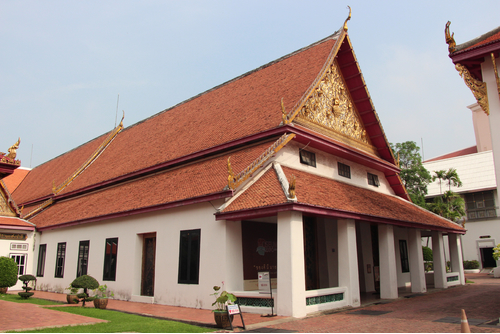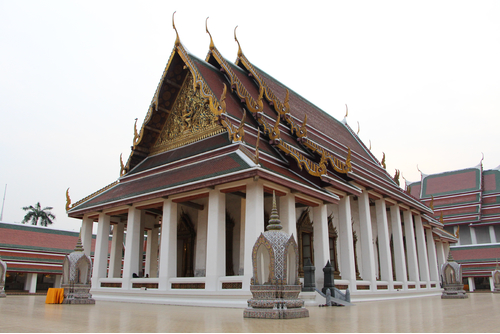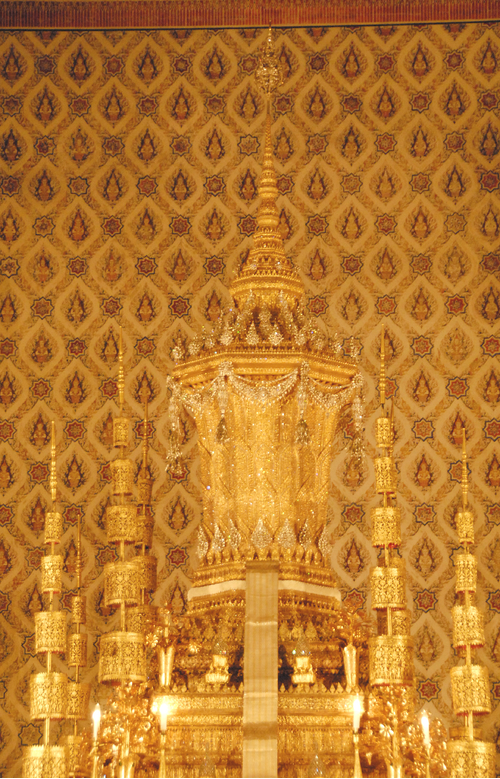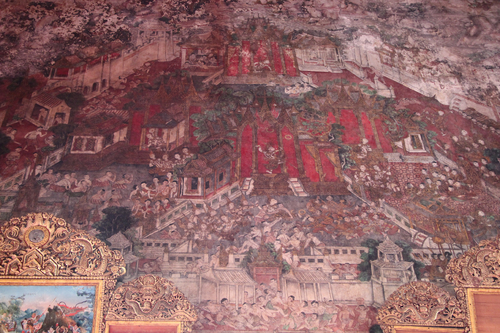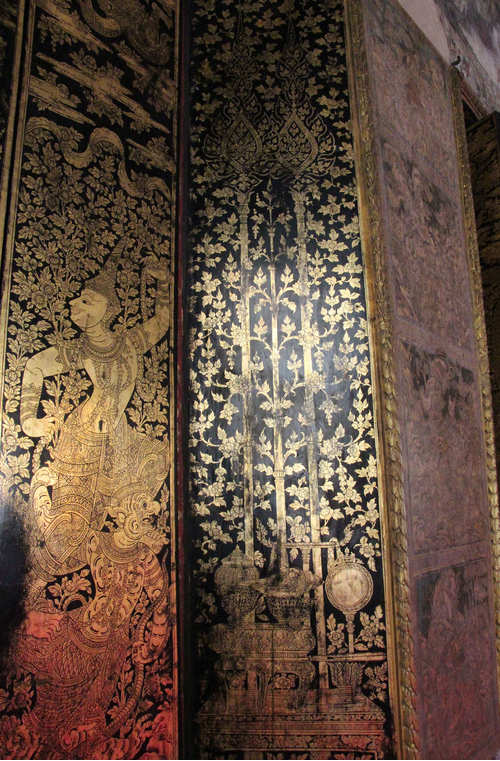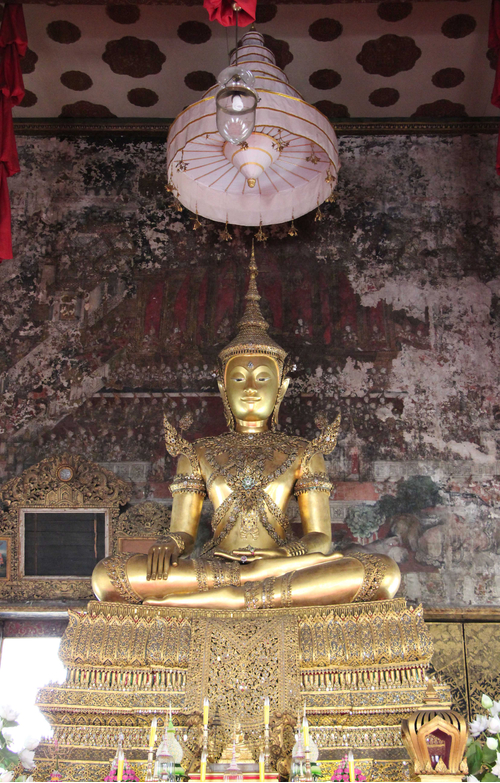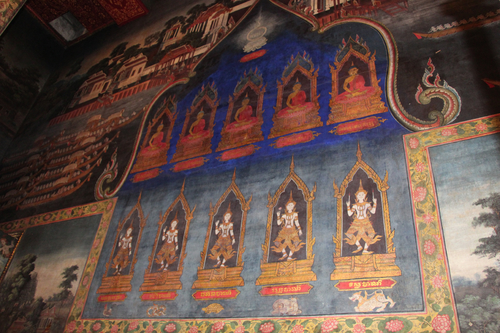ค้นหางานศิลปกรรม
ฐานข้อมูลศิลปกรรมในเอเชียตะวันออกเฉียงใต้
สถาปัตยกรรมพระที่นั่งอิศราวินิจฉัย
พระที่นั่งอิศราวินิจฉัยเป็นอาคารโรง ก่ออิฐถือปูน ชั้นเดียว ขนาด 10 ห้อง หันหน้าไปทางทิศตะวันออก ฝากั้นทึบทั้ง 4 ด้าน ด้านหน้ามีระเบียง เสาระเบียงและเสาในอาคารเป็นเสาสี่เหลี่ยมขนาดใหญ่แบบที่นิยมในสมัยรัชกาลที่ 3 ภายในประดิษฐานพระที่นั่งบุษบกมาลา หลังคาพระที่นั่งประดับด้วยเครื่องไม้มุงกระเบื้องดินเผาไม่เคลือบสี ประดับกรอบหน้าบันด้วยช่อฟ้า ใบระกา หางหงส์ หน้าบันประดับรูปเทพนมประทับบนฐานบัวแกมช่อกระหนกเปลว ปิดทองประดับกระจก
สถาปัตยกรรมวัดสระเกศ
พระอุโบสถเป็นอาคารแบบไทยประเพณี หลังคาเครื่องไม้ซ้อนชั้น ประดับเครื่องลำยอง ประกอบด้วยช่อฟ้า ใบระกา นาคสะดุ้ง หางหงส์ หน้าบันประดับรูปพระนารายณ์ทรงครุฑทำด้วยไม้แกะสลักปิดทองประดับกระจก ซุ้มประตูหน้าต่างทรงบันแถลง มีเสาพาไลโดยรอบพระอุโบสถ พนักระเบียงรอบพระอุโบสถประดับกระเบื้องปรุ มีซุ้มสีมาทรงกูบทั้ง 8 ทิศประดับกระเบื้องเคลือบสีที่สั่งทำจากประเทศจีน พระอุโบสถล้อมรอบด้วยระเบียงคดที่ประดิษฐานพระพุทธรูปนั่งเรียงรายทั้ง 4 ด้าน
ประติมากรรมพระโกศทองใหญ่
พระโกศทองใหญ่มีลักษณะคล้ายภาชนะ ส่วนฐานทรงแปดเหลี่ยมรองรับส่วนกลางทรงแปดเหลี่ยมที่มีเอวคอด ปากผาย ประดับดอกไม้เอวที่ขอบล่าง และประดับเฟื่องกับพู่เงินที่ขอบบน ภายนอกสลักลวดลายกลีบบัว ส่วนบนหรือฝาพระโกศซ้อนชั้นลดหลั่นประดับดอกไม้ไหว ส่วนปลายเรียวแหลมประดับดอกไม้เพชรพุ่มข้าวบิณฑ์ที่ยอดบนสุด
จิตรกรรมจิตรกรรมเรื่องชมพูบดี
จิตรกรรมมีสภาพค่อนข้างลบเลือน ผนังด้านตรงข้ามพระประธานเขียนตอนพระอินทร์จำแลงกายมาเป็นทูตเชิญเสด็จพระเจ้าชมพูบดีไปยังเวฬุวัน ผนังด้านทิศเหนือเขียนตอนกระบวนเสด็จของพระเจ้าชมพูบดี ผนังด้านหลังพระประธานเขียนตอนพระเจ้าชมพูบดีเข้าเฝ้าพระพุทธเจ้า ผนังด้านทิศใต้เขียนตอนกระบวนเสด็จของกาญจนราชเทวีพระมเหสี จิตรกรรมฝาผนังมีรูปแบบและเทคนิคอย่างจิตรกรรมไทยประเพณีในสมัยรัชกาลที่ 3 โดยตัวละครแสดงกิริยาอย่างนาฏลักษณ์ พื้นหลังฉากปราสาทใช้สีแดงชาด คั่นฉากเหตุการณ์สำคัญด้วยกำแพงเมือง แนวพุ่มไม้ หรือโขดหิน ภาพปราสาทราชวังยังคงเป็นแบบไทยประเพณี ในขณะที่ภาพอาคารบ้านเรือนมีการจำลองภาพอาคารตามสมัยนิยม
จิตรกรรมลายรดน้ำเครื่องราชูปโภค
จิตรกรรมลายรดน้ำที่บานแผละประตูและหน้าต่างภายในพระอุโบสถวัดนางนองมีทั้งหมด 28 ภาพ เขียนภาพเครื่องราชูปโภค เครื่องราชกกุธภัณฑ์ เครื่องยศ เครื่องสิริมงคล เครื่องศัตราวุธ เครื่องดนตรีที่ใช้ประกอบพระราชพิธีต่างๆ โดยมีภาพเครื่องสูง ได้แก่ ฉัตร บังสูรย์ บังแทรก ประกอบอยู่เบื้องหลัง ลวดลายทั้งหมดปิดทองคำเปลวบนพื้นรักสีดำ
จิตรกรรมจิตรกรรมลายกำมะลอ
ภาพจิตรกรรมลวดลายอย่างจีน เขียนด้วยสีฝุ่นผสมทองคำเปลว บนพื้นรักสีดำเป็นรูปเทพเจ้าฮก ลก ซิ่ว ตามคติความเชื่อในลัทธิหรือศาสนาเต๋า แต่งกายอย่างจีน พร้อมด้วยบริวาร
ประติมากรรมพระพุทธมหาจักรพรรดิ
พระพุทธรูปประทับนั่งขัดสมาธิราบ แสดงปางมารวิชัย พระวรกายเพรียว พระพักตร์ค่อนข้างกลมกึ่งรูปไข่ พระขนงโก่ง พระเนตรเรียวเล็ก พระโอษฐ์อ่อนโค้งเล็กน้อยจนเกือบเป็นเส้นตรง พระพักตร์คล้ายหุ่น อันเป็นรูปแบบเฉพาะของพระพุทธรูปในรัชกาลที่ 3 ทรงเครื่องประดับต่างๆ ได้แก่ พระมหามงกุฎ กรองศอ สังวาล พาหุรัด ทองพระกร ทองพระบาท
สถาปัตยกรรมจิตรกรรมเรื่องพระพุทธเจ้าและพระโพธิสัตว์มหายาน
องค์ประกอบของภาพจิตรกรรมเรื่องนี้เขียนบนฉากหลังสีน้ำเงินเข้มมีกรอบคดโค้งยอดแหลม ภายในพื้นที่นั้นประกอบด้วย ภาพพระพุทธรูป 5 พระองค์ ประทับนั่งเรียงเป็นแถว พระพุทธรูปแต่ละองค์ครองจีวรสีเข้มเกือบเป็นสีแดง ห่มจีวรเฉียง ผ้าจีวรเรียบไม่มีริ้ว มีสังฆาฏิเป็นแถบขนาดเล็กพาดจากพระอังสาซ้ายยาวจรดพระนาภี พระพักตร์และพระวรกายปิดทอง เหนือพระเศียรมีพระรัศมีเปลวปิดทองโดยไม่มีอุษณีษะ ซึ่งเป็นลักษณะสำคัญของพระพุทธรูปแบบพระราชนิยมในรัชกาลที่ 4 พระพุทธรูปทุกองค์แสดงปางสมาธิ ประทับนั่งบนฐานกลีบบัวซึ่งรองรับด้วยฐานสิงห์ภายในเรือนแก้วที่มีลักษณะเป็นซุ้มคดโค้ง ปลายซุ้มทั้ง 2 ข้างมีลักษณะคล้ายหางหงส์หรือเศียรนาคที่หันหน้าไปด้านข้าง ยอดกลางเป็นกระหนกคล้ายกับเศียรนาคหันหน้าตรง ด้านบนซุ้มประดับพุ่มไม้โพธิ์มีลายกระหนกเปลวล้อม ซึ่งลักษณะดังกล่าวเป็นรูปแบบของซุ้มพระพุทธรูปแบบพระราชนิยมในรัชกาลที่ 4 เช่นกัน ใต้ฐานพระพุทธรูปแต่ละองค์มีกรอบข้อความอักษรขอมสีทองบนพื้นสีแดงเหนือแถวภาพพระพุทธรูปทั้ง 5 พระองค์ มีรูปอุณาโลมเปล่งรัศมีเหนือดอกบัว กลางอุณาโลมมีอักษรขอม ใต้ดอกบัวมีอักษรขอมบนพื้นสีแดง ด้านล่างของแถวพระพุทธรูปเป็นภาพบุคคลแต่งกายคล้ายเทวดา 5 องค์ ทุกองค์ทรงเครื่องประดับซึ่งมีการปิดทอง ประกอบด้วยมงกุฎมีกรรเจียกจร กรองศอ สังวาล พาหุรัด ทองกร นุ่งผ้าเขียนลายประดับชายไหวชายแครง สวมทองพระบาทและฉลองพระบาท ประทับยืนบนแท่นประดับผ้าทิพย์ ภายในซุ้มเรือนแก้วที่คล้ายกับซุ้มเรือนแก้วของพระพุทธรูปทั้ง 5 องค์ แต่ไม่มีไม้โพธิ์ประดับ ใต้ฐานที่ประทับของแต่ละองค์มีกรอบข้อความอักษรขอมสีทองบนพื้นสีแดง พร้อมทั้งมีภาพสัตว์ ได้แก่ ไก่ นาค เต่า โค และสิงห์ภาพทั้งหมดนี้มีความเกี่ยวข้องกับคติความเชื่อในพุทธศาสนามหายาน เนื่องจากอักษรขอมที่ปรากฏใต้ภาพพระพุทธรูปแต่ละองค์นั้นอ่านได้ว่า “ไวโรจนะ” “อักโษภยะ” “รัตนสัมภาวะ” “อมิตาภะ” และ “อโมฆสิทธิ” โดยเรียงตามลำดับจากซ้ายไปขวา ซึ่งชื่อดังกล่าวสอดคล้องกับข้อความอักษรขอมที่อยู่ใต้รูปอุณาโลม และอยู่เหนือภาพพระพุทธเจ้าเหล่านั้นซึ่งอ่านได้ว่า “ธยานิพุทธา”ส่วนอักษรขอมที่อยู่ใต้ภาพบุคคลที่แต่งกายคล้ายเทวดาทั้ง 5 องค์นั้น อ่านได้ว่า “สมันตภัทร” “วชิรปาณี” “รัตนปาณี” “ปัทมปาณี” และ “วิศวปาณี” ดังนั้นจึงสอดคล้องกับภาพพระธยานิพุทธเจ้าแต่ละองค์ที่มีพระโพธิสัตว์ประจำองค์อยู่เบื้องล่าง และเชื่อว่าภาพสัตว์ที่อยู่เบื้องล่างของพระโพธิสัตว์แต่ละองค์นั้น เป็นสัญลักษณ์สื่อแทนพระพุทธเจ้าทั้ง 5 องค์ที่ตรัสรู้ในโลกมนุษย์ ภาพอุณาโลมที่อยู่ด้านบนสุดนั้น ภายในมีอักษรขอม 3 ตัวซึ่งอ่านได้ว่า อะ อุ มะ หรือ โอม อันเป็นคำกล่าวสรรเสริญบูชาเทพเจ้าตามคติความเชื่อในศาสนาพราหมณ์มาแต่โบราณ แต่น่าสนใจว่าได้นำมาเขียนไว้เหนือข้อความและภาพของพระธยานิพุทธเจ้าซึ่งเป็นเรื่องในพุทธศาสนา
